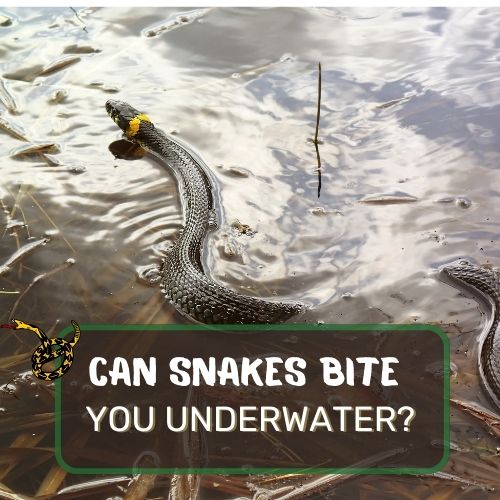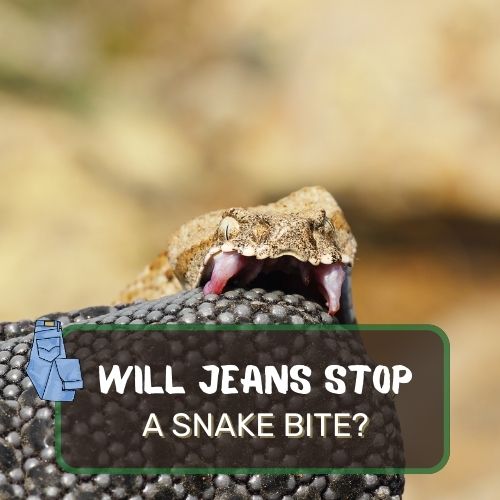
Diving into the intriguing world of reptilian behavior, we confront a question that often sparks curiosity: “Can snakes bite you underwater?”
This article explores the unique phenomenon of snake bites in aquatic environments, shedding light on the types of snakes capable of such actions, the mechanics behind underwater bites, and the potential risks involved.
Delve into the realm of these adaptable creatures as we unravel the factors that influence their behavior, provide safety precautions, and dispel common myths.
By the end, you’ll emerge with a comprehensive understanding of the complexities surrounding snake encounters beneath the waves, equipping you with valuable insights to navigate aquatic settings with confidence.
Table of Contents
Can a Snake Bite You Underwater? (Quick Answer)
Yes, certain species of snakes, such as aquatic and semi-aquatic ones like the cottonmouth snake and sea snakes, are capable of biting underwater. These snakes have adapted to their aquatic environments and can open their jaws to deliver a bite. While the force of the bite might be different underwater, it’s important to exercise caution when swimming or diving in areas where these snakes are present, as their bites can still be venomous and pose a risk to humans.
Snakes That Bite Underwater

When we think of snakes, we often picture them slithering through grass or coiled up on a branch, ready to strike. However, did you know that some snakes are equally capable of delivering a bite while submerged in water?
It’s a fascinating aspect of these remarkable creatures that deserves a closer look.
Types of snakes that have the ability to bite underwater
Not all snakes possess the capability to bite underwater. Among those that do, aquatic and semi-aquatic species are the primary contenders. These snakes have adapted to life in or around water bodies, whether it’s a serene lake, a murky pond, or even a slow-moving river.
Examples of aquatic snakes that are known to bite underwater
One prime example is the cottonmouth snake (Agkistrodon piscivorus), also known as the water moccasin. This venomous serpent is often found near water sources in the southeastern United States.
Another intriguing example is the sea snake, a creature perfectly designed for life in the ocean. These snakes, such as the banded sea krait, have evolved to hunt and navigate underwater, and yes, they can deliver a bite even beneath the waves.
Factors that may provoke snakes to bite while underwater
Just like their counterparts on land, underwater snakes may bite when they feel threatened or cornered. The water might add an extra layer of defense, but it doesn’t necessarily make them docile.
Snakes might also mistake a human for prey, especially if the person is moving in a way that triggers the snake’s hunting instincts.
It’s important to remember that, even in water, maintaining a respectful distance from these creatures is essential for both your safety and theirs.
How Snakes Bite Underwater

Now that we know certain snakes can indeed bite underwater, let’s delve into the mechanics of how they manage to do so. It’s a tale of jaw flexibility, adaptation, and a bit of snake ingenuity.
Anatomy of snake jaws and how they can open their mouths underwater
Snakes possess an incredible ability to open their mouths wide to swallow prey whole. This jaw flexibility becomes even more crucial when they’re underwater.
The anatomy of their skulls allows them to unhinge their jaws and stretch their mouths significantly, accommodating the task of biting even in submerged conditions.
Imagine a snake’s mouth expanding to encompass its target – a feat that’s both fascinating and slightly eerie.
Techniques used by snakes to bite underwater
When it comes to biting underwater, snakes employ different techniques depending on their surroundings. Some might stay partially submerged, with only their heads above water, ready to strike at any potential threat.
Others might fully submerge themselves and approach their target with stealth. The effectiveness of their strikes varies, but it’s evident that these reptiles are resourceful and adaptable predators.
Impact of water on the effectiveness of a snake’s bite
Water is denser than air, which poses an interesting challenge for snakes trying to bite underwater. The resistance offered by water might slightly dampen the force of their bite, making it different from a strike on land.
However, this doesn’t necessarily mean that a snake’s bite is harmless underwater. Venomous snakes, for instance, can still deliver a toxic dose even if their bite isn’t as forceful.
Frequency of Snake Bites Underwater

While snake bites underwater might not be an everyday occurrence, they are not as rare as one might think. Let’s delve into the frequency of these encounters, shedding light on when and where they are most likely to happen.
The Lack of Statistics on the frequency of snake bites underwater
Accurate statistics on the exact frequency of snake bites underwater are somewhat challenging to gather due to the nature of these incidents often happening in remote or less-documented areas.
However, anecdotal evidence and reports from researchers and adventurers suggest that such encounters do happen.
Common scenarios where snake bites occur underwater
Snake bites underwater can occur in a variety of scenarios. Swimmers and divers exploring natural water bodies, like lakes, rivers, and even oceans, might inadvertently come into contact with snakes.
Furthermore, activities such as fishing, boating, and snorkeling can increase the chances of encounters with these aquatic reptiles.
Factors that increase the likelihood of a snake bite underwater
Several factors can heighten the likelihood of snake bites underwater. Disturbing a snake’s habitat or accidentally coming too close to them while swimming or diving can provoke defensive behavior.
Additionally, a lack of awareness about the presence of snakes in specific areas and improper handling of these creatures can lead to unfortunate interactions.
Dangers of Snake Bites Underwater

Snake bites are concerning enough on land, but what about underwater? Let’s explore the potential dangers and consequences associated with snake bites in aquatic environments.
Venomous snakes and their potential for causing harm underwater
Some of the snakes capable of biting underwater are venomous, adding an extra layer of danger to these encounters. The potency of their venom and their ability to inject it effectively can turn a snake bite into a serious medical emergency.
The cottonmouth, with its potent venom, and various species of sea snakes, are examples of underwater serpents with the potential to cause harm.
Health risks associated with snake bites underwater
Being bitten by a snake underwater introduces unique health risks. The venom injected underwater might disperse differently in the body compared to bites on land.
This dispersion could affect the rate of absorption and potentially alter the symptoms experienced by the victim.
Swelling, pain, and other typical snakebite symptoms might manifest differently due to the influence of water.
Immediate and long-term effects of snake bites while submerged
The immediate effects of a snake bite underwater can include pain, swelling, and potentially difficulty breathing if the bite occurs in a sensitive area. In some cases, victims might experience an allergic reaction to the venom.
Long-term effects can vary depending on the severity of the bite and the type of snake. These effects could range from tissue damage and scarring to psychological trauma from the experience.
Understanding the potential dangers of snake bites underwater is crucial for anyone who frequents aquatic environments.
Whether you’re a swimmer, diver, or simply someone who enjoys spending time near water, being informed about the types of snakes in your area and adopting safety precautions can go a long way in preventing unfortunate encounters.
Precautions and Prevention

As the saying goes, “Forewarned is forearmed.” When it comes to snake bites underwater, taking proactive measures can significantly reduce the risk of unfortunate encounters.
Let’s explore some safety measures and tips to help you stay safe while enjoying aquatic environments.
Safety measures to minimize the risk of snake bites underwater
- Know the Area: Familiarize yourself with the water bodies you plan to explore. Research the types of snakes that inhabit those areas and their habits.
- Protective Gear: If you’re swimming or diving in areas known for snake activity, consider wearing protective gear like thick wetsuits or rash guards to reduce the potential for bites.
- Avoid Hiding Spots: Snakes often seek refuge in hiding spots like rocks, crevices, or aquatic vegetation. Be cautious around these areas and avoid putting your hands or feet in places you can’t see clearly.
Tips for identifying and avoiding snakes while swimming or diving
- Stay Calm: If you spot a snake while underwater, try to remain calm. Slow and steady movements are less likely to provoke the snake.
- Maintain Distance: Give any snake you encounter a wide berth. Avoid the temptation to get closer for a better look.
- Avoid Shadows and Reflections: Snakes might mistake your shadow or the glare from your equipment for prey. Minimize sudden movements that could attract their attention.
Importance of understanding snake behavior and habitats
Educating yourself about the behavior and habitats of snakes is a key aspect of preventing bites underwater.
Knowing where they like to hide, their activity patterns, and how they respond to human presence can help you make informed decisions while enjoying aquatic activities.
What to Do if Bitten Underwater

Despite all precautions, accidents can still happen. If you find yourself in the unfortunate situation of being bitten by a snake underwater, it’s crucial to know how to respond swiftly and effectively.
Steps to take immediately after a snake bite while underwater
- Stay Calm: Panicking can elevate your heart rate and potentially hasten the spread of venom. Take deep breaths and try to remain as calm as possible.
- Get to the Surface: If you’re underwater when bitten, slowly ascend to the surface while maintaining a controlled pace to avoid decompression sickness.
- Signal for Help: If you’re diving with a buddy, use established underwater signals to communicate your situation. They can assist you in reaching the surface safely.
Emergency first aid for snake bites in a water environment
- Remove Yourself from the Water: Once at the surface, move away from the water’s edge to prevent further exposure to potential snake habitats.
- Immobilize the Affected Area: If possible, keep the bitten area as still as you can to slow the spread of venom.
- Clean the Wound: Rinse the wound gently with clean water if available, but do not scrub or apply any substances.
Importance of seeking medical attention and professional help
After a snake bite, even underwater, seeking medical attention is paramount. Even if the bite seems minor, the presence of venom and the potential for adverse reactions make professional medical evaluation necessary.
Antivenom might be required, and medical professionals can monitor your condition for any delayed symptoms.
In essence, staying informed about safety measures, understanding snake behavior, and knowing how to respond in the event of a snake bite underwater can make all the difference in ensuring a safe and enjoyable experience in aquatic environments.
Snake Bite Myths and Misconceptions

As with many topics, snake bites underwater come with their fair share of myths and misconceptions. Let’s separate fact from fiction by addressing some common misconceptions and providing accurate information to promote better understanding.
Debunking common misconceptions about snake bites underwater
- Snakes Never Bite Underwater: While some snakes might be less aggressive underwater, certain species are fully capable of biting when threatened or provoked, regardless of their environment.
- Water Makes Snakes Harmless: Water might alter the force of a snake’s bite, but it doesn’t necessarily render them harmless. Venomous snakes can still deliver toxic bites underwater.
Addressing myths about snake behavior and capabilities in water
- Snakes Always Chase Swimmers: Snakes don’t chase humans intentionally. They might move in the same direction due to their natural instincts, but they’re not actively pursuing humans as prey.
- Snakes Can’t Bite through Clothing: Some snakes possess sharp fangs capable of penetrating clothing, including rubber boots. Thick clothing can provide some protection, but it’s not foolproof.
Promoting accurate information to ensure public safety
Dispelling myths and providing accurate information about snake behavior and bites underwater is crucial for public safety. By understanding the true capabilities and tendencies of snakes, individuals can take appropriate precautions without unnecessary fear.
FAQ
To further clarify common questions and concerns related to snake behavior underwater, let’s address some frequently asked questions:
What to do if a snake chases you?
Snakes do not chase humans. If you encounter a snake, stay calm, slowly back away, and allow the snake to move on. Avoid sudden movements that might startle the snake.
Can snakes bite through rubber boots?
While rubber boots offer some level of protection, certain snake species have fangs capable of puncturing rubber. It’s safer to avoid areas where you might encounter snakes, regardless of your footwear.
How long can snakes stay underwater?
This varies by species. Some aquatic snakes can stay submerged for up to 30 minutes, while others might be able to hold their breath for several hours.
Can all snakes swim underwater?
Most snakes can swim to some extent, but not all are well-adapted for aquatic environments. Some species are better swimmers than others, and their ability to navigate underwater can vary.
Conclusion
Exploring the world of snakes and their ability to bite underwater has led us through a journey of adaptation, behavior, and safety.
While the idea of snake bites underwater might be unsettling, understanding the nuances of these interactions can empower us to make informed decisions and mitigate risks.
Remember, certain snakes can indeed bite underwater, especially in their natural habitats. This knowledge should encourage caution and respect when enjoying aquatic environments.
By adopting safety measures, familiarizing ourselves with snake behavior, and dispelling myths, we can coexist with these fascinating creatures while minimizing the chances of unfortunate encounters.
Whether you’re a swimmer, a diver, or simply someone who enjoys spending time by the water, the key is to strike a balance between curiosity and caution.
Armed with accurate information and an awareness of the natural world around us, we can create a safer space for both humans and these slithering denizens of the water.
So, dive in with awareness, explore with care, and embrace the beauty of aquatic environments while respecting the serpentine inhabitants that call them home.




0 Comments